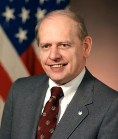National Cemetery Administration
Directors & Under Secretaries for Memorial Affairs, 1973 to Present (2 of 5)

Paul Takeo Bannai
Chief Memorial Affairs Director
National Cemetery System
Veterans Administration
(1981–1985)
Paul T. Bannai was appointed to the position of Chief Memorial Affairs Director at the Veterans Administration (VA) under President Ronald Reagan, a post he held from December 7, 1981, until September 30, 1985. During Bannai's tenure, several existing national cemeteries were reopened for burials, while new cemeteries were opened on lands acquired from nearby military bases, including facilities at Fort Custer, MI; Indiantown Gap, PA; and Quantico, VA. During the same period, three new state veteran cemeteries opened in Maryland, Wyoming and Guam. Bannai earned the VA Administrator's Exceptional Service Award upon his retirement.
Prior to joining VA, Bannai became the first Japanese American elected to the State of California legislature (53rd Assembly District), where he served four terms, between 1972 and 1980. Bannai served on many committees, including Veterans Affairs. He was named Executive Director of the Commission on Wartime Relocation and Internment of Civilians.
Bannai was born in Colorado. At the start of World War II, he volunteered for military service from the Manzanar War Relocation Center, California, where his family had been placed. Bannai joined the Army's widely acclaimed 442nd Regimental Combat Unit—composed of Nisei soldiers, the "second-generation" of Japanese immigrants born in the United States. Bannai was assigned to the U.S. Army Intelligence Service. He saw action in New Guinea, the Halmaheras, and the Philippines, and he participated with the combined U.S. and Australian forces at the invasion of Borneo. After the surrender, Bannai served in General Douglas MacArthur’s headquarters with the Army of Occupation in Japan. Offered a commission as a second lieutenant, he declined due to concern for family members who remained interned at Manzanar. He was discharged in 1946 with the rank of first sergeant. Bannai died on September 14, 2019, at age 99 and is interred in Los Angeles National Cemetery (Section 62A, Row G, Site 6).

Wilfred Louis Ebel
Director
National Cemetery System
Department of Veterans Affairs
(1987–1989)
President Ronald Reagan appointed Wilfred L. Ebel as Chief Memorial Affairs Director at the Veterans Administration (VA) in July 1987. On March 15, 1989, the Veterans Administration was elevated to the Executive Branch's 14th cabinet post to become the Department of Veterans Affairs (VA). As part of the reorganization, Ebel was named as the first Director of the National Cemetery System, the title he held until his departure from NCS in April 1989.
During Ebel's tenure, the mission of assuring grave space for veterans continued. Facilities at Florida National Cemetery in Bushnell, and Ft. Mitchell National Cemetery in Phenix City, AL, were established, and the state cemetery in Phoenix, AZ, was transferred to NCS to become the National Memorial Cemetery of Arizona. At the same time, three new state veteran cemeteries were created in Connecticut, Montana and New Jersey.
Ebel's previous appointments included serving as Assistant Director, Deputy Director and Acting Director of the Selective Service System; Assistant Executive Officer to President Reagan's Military Manpower Task Force, and staff posts for Presidents Richard M. Nixon and Gerald R. Ford. The Nebraska native received a master's degree in International Relations from Syracuse University, an undergraduate degree from the Army War College, and has written about politico-military issues.
Ebel, a retired Army Reserve colonel and veteran of the Korean and Vietnam conflicts, has been awarded many decorations, including the Legion of Merit and Defense Meritorious Service medals, both with oak leaf cluster, Joint Service Commendation Medal, and Department of the Army Distinguished Service Award with oak leaf cluster. He was inducted into the Senior Army Reserve Commanders Association Hall of Fame in 1995. Ebel died July 3, 2018, at age 88; he is interred at Omaha National Cemetery (Section 1, Site 854).

Jo Ann Krukar Webb
Director
National Cemetery System
Department of Veterans Affairs
(1989–1991)
Jo Ann K. Webb became the highest-ranking woman in the Department of Veterans Affairs (VA) upon her appointment as director of the National Cemetery System (NCS) by President George H.W. Bush on October 10, 1989. While she headed the agency, development began on San Joaquin Valley National Cemetery and grave liners became mandatory burial features in national cemeteries. During the same period, five new state veteran cemeteries were established in Delaware, Hawaii, Nevada, Tennessee and Utah. She left in November 1991 to become VA's Assistant Secretary for Policy and Planning.
Webb previously worked in the Veterans Administration from 1978–1982. Before joining the department, she worked for several years as an analyst and health-care consultant for ACTION, the national domestic volunteer agency. She served as the director of a health-service corporation, and she was an original member of VA's Advisory Committee of Women Veterans, from 1983–1986.
A native of Pennsylvania, Webb earned a bachelor's degree in nursing at Pennsylvania State University, after which served five years in the Army on active duty in Vietnam, Germany, and Walter Reed Medical Center in Washington, D.C. She was awarded the Army Commendation Medal for service in Vietnam. Subsequently she earned a master's in healthcare administration from George Washington University. From 1976–1980 she was the public health officer for the Army Reserve's 354th Civil Affairs Group, 82nd Airborne Division, from which she was discharged with the rank of captain.

















